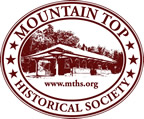MTHS Blog
Cemetery Tour & Twilight Inn Fire








Twain on the Mountain
Recently we were pleased to offer research support to two staff members from the Mark Twain House in Hartford, Connecticut who are putting together an exhibit on Samuel Clemens’ summer vacation experiences, including his time on the Mountain Top.

Samuel Clemens on the porch of the Wake Robin at Onteora Park in 1890.
During the summer of 1890, Samuel Clemens (pen name Mark Twain) and his family rented The Balsam cottage at Onteora Park, a private community and mountain retreat for writers, artists and wealthy families in Tannersville. After his stay, Clemens wrote his host and Park founder Candace Wheeler: “Dear Mrs. Wheeler,--It was the perfection of a visit: just enough rain, just enough sunshine; just enough people, & just the right kind; just enough exercise, just enough lazying around; just enough of everything desirable, & no lack of anything usual to the details of a lark away from home…If any should ask me if we had a good time there, I should answer that it was just a model case of ‘Oh hellyes!’”
Clemens’ visit to the Mountain Top in many ways overlapped with a golden period of his life. He was among the “who’s who” in America as a nationally celebrated author having recently published The Adventures of Tom Sawyer and its famous sequel Adventures of Huckleberry Finn. Not long after his stay at Onteora, Clemens would experience a devastating series of financial misfortunes and the untimely deaths of his two young daughters and wife.


A portrait of Samuel Clemens by Carroll Beckwith, painted at Onteora Park in 1890.
While Clemens did not manage to finish any writing at Onteora Park, he delighted Park members with readings, enjoyed meals accompanied by a live orchestra, partook in evening dances, staged impromptu plays with his young daughters, and sat for a portrait by Carroll Beckwith (see above). Clemens also joined in on a gentleman’s bear hunt, a popular thrill for wealthy summer residents. Doris West Brooks recounted the story of Clemens and the bear hunt in a 1986 edition of The Hemlock:
“It wasn’t unusual for a hunting party to come down from Onteora Park to Uncle David’s home in the East Kill Valley. A bear would be released from the cage down by the creek for the gentlemen hunters to shoot. It was at the height of Twain’s popularity that he decided to join just such a party. A friend of Twain’s, with a new invention, a movie camera, accompanied him. By the time the hunting party was underway, there were numerous ladies and men in the entourage.
The ladies were attired in their white gowns and carried pastel parasols. The man with his movie camera and numerous gentlemen with rifles all descended on David and Etta, his wife. The ladies were given chairs aligned along the back of the house. Aunt Etta served them lemonade. The men stood down by the creek with guns ready. Mark Twain’s friend stood by to capture this moment for posterity. He would have a memorable news reel indeed!
Uncle David opened the cage door and prodded the bear to leave. The bear came charging out. He was supposed to go running across the creek so the men could get a good shot at him, but instead came charging directly into the group of men, scattering them in all directions. The cameraman dropped his wonderful new toy. The ladies were all very satisfactorily hysterical.”
The exhibit at the Mark Twain House detailing Clemens' time on the Mountain Top is slated to open in 2023. We look forward to visiting.
-Alexandra

Inside the Archives: A Q&A with Bob Gildersleeve & John Curran
From the Spring 2022 edition of The Hemlock

Every Wednesday, MTHS board members Bob Gildersleeve and John Curran volunteer their time to manage and digitize the extensive collections held in the MTHS Archives. After a year-long hiatus due to the Covid-19 pandemic, Bob and John have been back in the archives working diligently all winter to make up for lost time. The following Q&A provides a closer look at the important work they are engaged in.
Q: What is your connection to the Mountain Top?
John: I have lived on the Mountain Top my entire life. Growing up on Osborne Road in Haines Falls, the North-South Lake recreation area was close enough to walk or bicycle to. I spent a lot of time there as I was growing up and learned to appreciate the beauty of the mountains and nature. It is still one of my favorite places. I have been on the MTHS Board since 2009 when I retired from the New York State Office of General Services. Bob Gildersleeve started teaching me the workings of the Archives shortly thereafter and I have been enjoying it ever since.
Bob: Even though my roots go back eleven generations in New York State, I’m not a native to the Catskills. I was born in Newburgh, NY and came here to teach at Hunter Tannersville Central in the 1970s. I immediately became interested in the region. I’ve been working with the Archives since it was established from materials collected by Justine Hommel and others.
Q: How would you describe the MTHS Archives?
John: Our archives are comprised mostly of documents and photographs related to our local history. The items are cataloged, scanned and the pertinent searchable data is entered into our Past Perfect database. The items are then stored in archival-grade containers in our climate-controlled, fire-resistant Archives. Many items are used in temporary displays and as learning aids during programs. All items are available for public viewing upon request.
Bob: The collection is almost exclusively paper items including photographs, postcards, books, brochures, deeds, letters from the 19th and early 20th centuries, a diary or two, and business papers. There are also a few fabric items.
Q: Why are the Archives important?
John: Historical documents are continually aging. If not stored properly, they will deteriorate. Our climate-controlled, highly fire-resistant archives provide a safe place to store documents. We only use archival grade storage materials. Documents not stored properly are also subject to loss and or damage.
Bob: Preserving the history of any community is important to its residents, and certainly our Mountain Top is no exception. Some communities, however, have more than local significance. In many ways, our Mountain Top has national and even international importance. The Society gets frequent requests for information from around the US and occasionally from abroad. The reasons are many: the importance of the Greene County Catskills in American art and literature, the area’s impact on tourism, and its recreation history.
Q: Every week you volunteer your time working in the Archives. What draws you to this work?
John: Learning local history and sharing what I have learned. I can’t just enter an item into our database without reading or studying it. If it is something I am familiar with, I share what I know about it. If it is something I am not familiar with, I ask questions and research. Yes, it can slow the process, but it keeps our work interesting and keeps us coming back.
Q: What are some of the tasks you perform in the Archives?
John: Mostly I enter items into our searchable Past Perfect database, which includes assigning an Accession and Object number, scanning the item and entering the pertinent data. I also do research to identify people, places and things; respond to inquiries; provide material for MTHS displays and programs; and eventually store the items.
Q: What is your favorite collection or item the Archives hold?
John: Oddly, one of my favorite items is something we do not physically have. We only have a high-resolution image of it. This is the 1883 Hexamer Survey of the Hotel Kaaterskill. The Hexamer Survey is a fire safety survey of the Hotel Kaaterkill performed by Hexamer & Sons of Philidelphia. It has detailed drawings of the layout of the hotel and descriptions of its various infrastructures. Having had a career in construction, I found this item not only fascinating, but invaluable to our research on the Hotel Kaaterskill. It has been used on hikes to the site and has enabled us to make sense of the layout of the huge hotel. We are indebted to our friend Scott Koster for sharing his finding with us, and The Philadelphia Free Library for providing a high-resolution scan of the document.

Bob: In particular, I like a beautiful photo-realistic painting by Robert Skiba that shows both the Catskill and Tannersville and the Ulster and Delaware Railroads. Skiba started with a Detroit Photographic Company image of Haines Falls in the collection of the Library of Congress. Through careful research and with great skill, he added details including the Coal and Hay company, the siding and stone wall and trains.
Q: What projects are you working on currently?
John: I have been working on the Joan Wright and Doug Griffin Collections. Mrs. Wright is a descendent of the Haines and Dunn families and provided us with a large collection of family photographs, writings, and family history; most are labeled with names and dates. Mr. Griffin’s collection consists of about 260 postcards of local and nearby places. There are several rare and unusual postcards, many are unused and all are in excellent condition.
Q: What is your future vision for the Archives and how they will be used by the public?
John: I would eventually like to see our database available to the public online. This would be a monumental task to accomplish, but it is my hope that someday it will come to pass.
Bob: We’d like to make better use of the Joan Brower collection and genealogical information. Neither of us are genealogists, and, except for dabbling into our personal family histories, are not equipped to round out the collection.
Q: What are some of the Archives’ more significant collections?
John: Two that stand out to me are the Joan Brower Collection and the Bob Mazon Collection. The Joan Brower Collection traces the Brower family history, but it is much more than that. Mrs. Brower traces the family history of the Brower spouses and the history of the professions and trades the Brower family occupied. It was all done pre-internet and consists of many large organized and indexed binders filled with letters, photos, newspaper clippings and much more. The Bob Mazon Collection is a huge mainly digital collection of photographs. Bob Mazon was a local photographer who through his photography, documented many local events, news stories, local landscapes, local places and much more from the 1980s up through his death in 2014. The collection will be an extremely valuable resource to future generations. We are grateful that both of these people entrusted their collections to us.
Contact Bob and John at This email address is being protected from spambots. You need JavaScript enabled to view it. to inquire about volunteer opportunities in the Archives
“The Lord and the Devil and the Bleu Mountains”

Page 1 of 17



